Iris flower
Iris flower specifications
- Scientific name : Iris reticulate
- Tribe : Irideae
- Family : Iridaceae
- Subfamily : Iridoideae
- Genus : Iris
- Plant Type : Perennial
- Mature Size : 6 in. to 4 ft. tall
- Sun Exposure : Full sun
- Bloom Time : Late spring, early summer, and late summer
- Flower Color : Varying shades of purple, blue, white, yellow
- Origin : Europe, the Middle East and North Africa, Asia and throughout North America
Iris flower have around 300 varieties in the Iris genus. These famous flowers are available in two main forms: those that grow from rhizomes and those that grow from bulbs. They feature unique blooms that are made up of two different kinds of petals, falls and standards. The falls form the lower petals, which droop downward or fall. The standards are the upper three petals of the flower.
The characteristics of an iris petal further segment the plant into three types: bearded, crested, and beardless. Bearded iris plants have soft hairs along their falls, resembling a beard. The flowers of a crested iris have a ridge-like crest on their falls. Beardless have neither hairs nor crests.
read more : Everything about okra plant : How to Plant & care for them

Irises that grow from bulbs include Iris reticulata, Spanish (Iris xiphium) and Dutch varieties (Iris x hollandica) and bloom earlier than the rhizomatous irises. However, most irises show their famous flowers in the early summer, while some also bloom for a second time in the late summer.
They are known for attracting butterflies and hummingbirds and make perfect cutting flowers. The iris varies greatly in size, from the smallest dwarf variety, which only grows to 6 inches tall, to the tallest variety which is up to 4 feet tall.
Introduction and botany of iris flower
Iris is a perennial plant with about 300 species and is distributed in the Northern Hemisphere. Each flower has 6 petals, 3 flags and 3 petals. The leaves are often sword-shaped, within each other and partly folded in the middle. The height of the iris varies between 20 and 5 cm. Iris flowers have 3 lower pieces with a pendant and 3 upper pieces standing as a flag. The range of iris color variations includes white, pale pink, blue, purple, pale purple, red, orange, and yellow.
In terms of plant organs, we have two types of iris. The first type, which has a rhizome iris, is used for planting in pots and gardens, and the second type, called bulbs iris, is used for cutting flowers and is used commercially. Iris blooms from mid-spring to early summer.
read more : Everything about opium poppy flower : How to Plant & care for them
Types of irises and its flowering season
A ) Rhizomes
This category includes the following :
-
Bearded or Pogon Iris
The characteristic of these irises is that they have a prominent line in the form of fluff in the middle of the pendants. The most important species in this category is the I. germanica. This plant is resistant to cold and drought. Its leaves are dagger-shaped and can be seen as evergreen in hot spots.
Its height reaches 20 to 50 cm. The colors of the flowers are purple, yellow, red and pink. Tall cultivars are sometimes used as cut flowers . Flowering is in mid-spring and early summer and may bloom twice a year, in spring and autumn. Grows with rhizomes after flowering.
Other species of bearded irises include I. pumila and I. Susiana that bloom in spring. Susiana iris has black flowers and other sad colors, which is why it is sometimes called mourning iris. It actually has gray petals with dark purple streaks, black spots and purple beards. I. pumila is very short and is sometimes called dwarf iris.
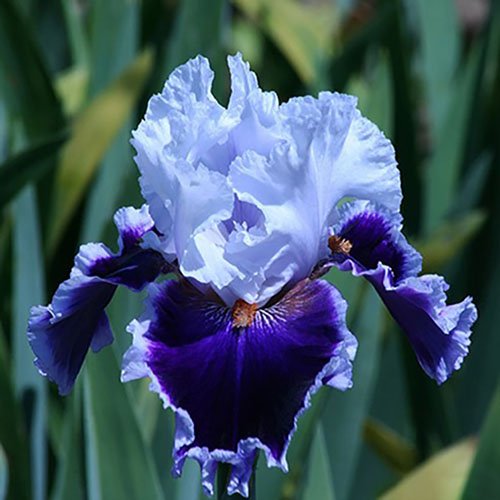
-
Beardless or Apogon
In this type of irises, the surface of the hangers is smooth and hairless. The leaves are thin and narrow and resemble the leaves of wheatgrass. Height varies from 30 to 120 cm. One of its important species is I. sibirica.
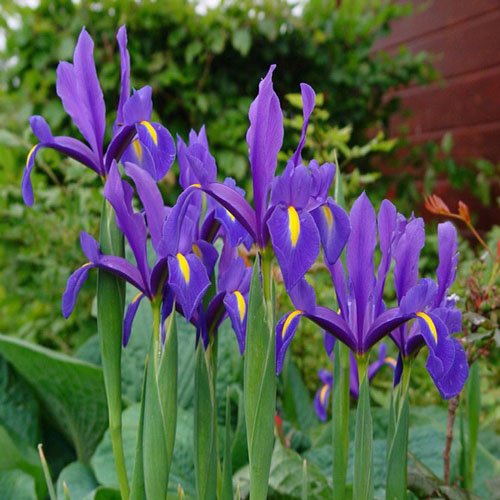
read more : Everything about nigella plant : How to Plant & care for them
-
Crestata Iris
The characteristic of this type of iris is that in the middle of the pendants, where the bearded irises have beards, these flowers are decorated with a crown and have a different color from the background color of the petals. This group is native to subtropical regions, but some species are resistant to cold.
Famous species in this group include I. japonica and I. cristata. These two species tolerate cold. Japonica iris blooms in summer and grows well in dry areas. Its height is about 60 cm, the flowers are large and purple with cut edges and the sepals are orange.
I. cristata is short and the plant height is 7-8 cm. The flowers are blue and the crowns are yellow or orange.

B ) Bulb irises
Bulb irises are divided into 3 groups : Juno, Reticulata and Xiphium. In the Reticulata group, all species are dwarf. Juno species have permanent fleshy roots, the removal of which causes plant death. This group is not resistant to cold. Therefore, they are not very important in the flower industry. Most of the irises used in potting are from the Xiphium group.
In floriculture, bulbous iriseses are divided into three groups : I. hollandica , I. xiphioides and I. xiphium . These flowers are widely used to cut flowers and decorate the garden. Some of them are hybrids and some are old species.
Bulbous irises are perennial bulbous plants whose primary bulbs (mother bulbs) are destroyed instead of one planting season, but during the growing season they produce a large bulb next to them, which will produce flowers next year.
read more : Everything about water lily flower : How to Plant & care for them
-
I. xiphioides or I. latifolia
It has thin, twisted leaves. The flowers are purple, purple and white and sometimes two colors. The plant flowers in late spring and early summer. This iris is grown in soil rich in organic matter and needs a lot of moisture during the activity.

-
I. xiphium
Its origin is Spain and Portugal. The flowers are very diverse, blue or purple and rarely white or yellow, with a yellowish tinge on each of the pendants. The only difference with I. xiphioides is the strange shape of its pendants.
The color variety of I. xiphioides is greater and its general shape is relatively uniform. In spring, it flowers 2 weeks earlier than the previous species. The bulbs are removed from the soil after flowering and stored in a suitable place.
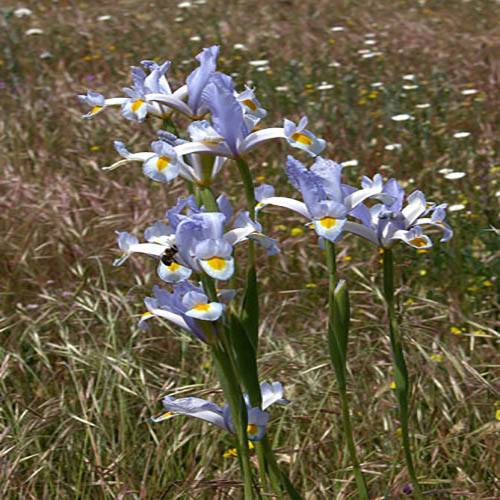
-
I. hollandica
This iris is the result of a cross between I. xiphium, I. tingitana and I. lusitanica. It is very diverse in terms of color and new colors are introduced to the market every day. Normally, this type of iris is ripened and cut flowers are used out of season. Other irises include I. reticulate and I. danfordia. Which are a variety of dwarf irises and are used to decorate apartments. The two bloom in March. The bulbs are planted in pots in the fall.
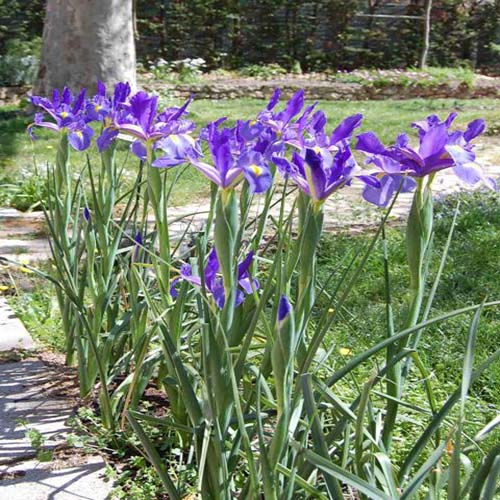
read more : Everything about red poppy flower : How to Plant & care for them
Propagation of iris varieties
The growth of irises is usually done by dividing the plant after the end of flowering. Also, by cultivating iris seeds, iris flowers can be observed after 3 years.
A ) Increase of rhizomes irises
Large perennial shrubs are removed from the ground in late summer and early fall after the leaves have turned yellow, the rhizomes are divided, and each part is planted separately in the original location.
If we want the plant to flower in the same year, we divide the rhizomes into large pieces, and if we want to increase the rhizomes more, we divide them into smaller pieces, but each rhizome piece must have at least one growth point. The rhizomes are planted at a depth of 5 cm in the soil. In areas with cold weather and long winters, the rhizomes may be destroyed.
B ) Increase of bulbous irises
In bulbous irises, bulbs are separated from the mother bulb in the fall and planted, which bloom in the first or second years.
Iran dried Iris flower
One of the bestselling medicinal plants is dried iris flower . This plant species has been the basis for the production of various medicines in the world, which is used in combination with other medicinal compounds.
Iris is one of Iran’s exports and has provided a great opportunity for Iranian traders to bring a lot of currency to the country by exporting dried iris flower. Both types of iris products can be exported either as medicinal plants or as decorative dried flowers because each has its own customer. The export of dried iris flower has provided a great opportunity for wholesalers and exporters of dried iris flower and other medicinal plants to make significant profits.
read more : Drying natural flowers | Introducing 8 wonderful ways to dry flowers
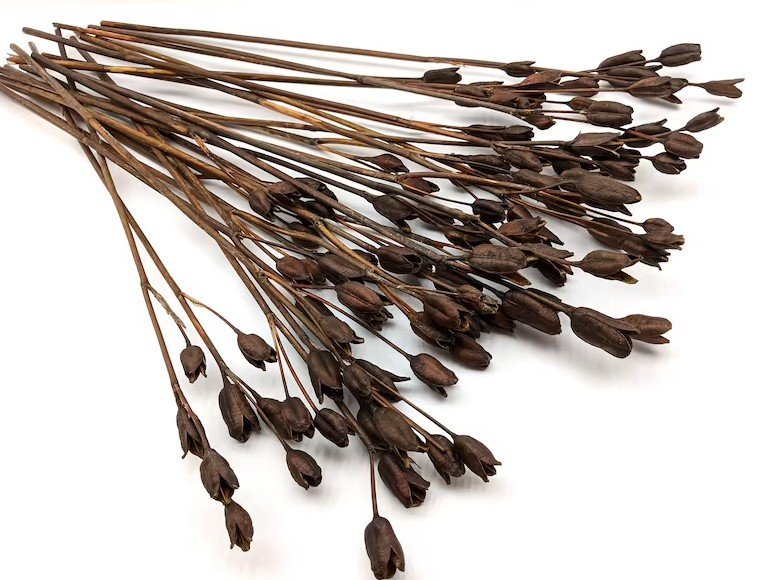
Iris flower Care
Different species of irises require slightly different methods of and timing for planting. Bulbous irises, which includes Dutch, Spanish, and reticulata irises, are planted in the fall in full sun in well-draining soil.
To plant your bulbs, loosen the soil, then mix in compost and 1/4 cup of all-purpose granular fertilizer according to the directions on the bag. Situate the bulbs 4 to 5 in. deep, depending on the type of bulb. For bearded irises, position rhizomes horizontally in the soil, leaving the top of the rhizome partially exposed. For other varieties, position the crown of the plant 1/2 to 1 in. below the the soil line.
Once flowers are spent, deadhead the blooms. When the whole stalk of flowers is spent, cut the stalk to the ground to direct energy to the roots, instead of forming seed heads. Once the first heavy frost comes or your leaves yellow for the season, you can cut your iris foliage to the ground to prevent iris bores from overwintering in the leaves. However, do not be tempted to remove the foliage before then, as the greenery is still performing photosynthesis, providing the plant with energy necessary for next year’s blooms.
Once the foliage is trimmed back for the winter, be sure to cover the rhizomes with something to help protect them, such as sand or mulch. Remove this in the spring. Irises are a great choice for areas with wildlife as they are deer resistant. Common pests include iris borers.
read more : Everything about rhaponticum repens : How to Plant & care for them
-
Light
Most iris varieties do best in full sun. Some varieties can tolerate partial shade, but too much shade will prevent them from flowering.
-
Soil
Rich, well-draining soil is best for iris plants. Though they like moist soil, too much water can be damaging. If you are worried about too much standing water, try planting your irises in raised beds, as this will allow for optimal water drainage. Japanese and Louisiana irises can tolerate moist soil and are excellent for areas near ponds. Siberian irises prefer acidic, moist soil.
-
Water
Because the iris likes both moisture and well-draining soil, watering consistently and deeply is very important. Just be sure not to overwater, as too much water in the soil can cause problems such as root rot. Though they appreciate consistent water, most iris varieties are drought-resistant and won’t die quickly if they are deprived of water for a short time.
-
Temperature and Humidity
With its wide range of varieties and growing zones, the iris is a hardy plant that can tolerate fluctuations in temperature and humidity. As long as the soil is well-draining and they get plenty of water and sunshine, these flowers can thrive in a large variety of gardens. Siberian, Bearded, and Japanese irises typically are hardy in USDA zones 3-9; Iris reticulata and Dutch iris are hardy in zones 5-9; and Louisiana iris prefers zones 6-9.
-
Fertilizer
Because irises prefer rich soil, compost makes a perfect amendment. Loosening the soil in the spring and adding a healthy layer of compost will help give your irises the nutrients they need to grow healthy and lush.
If you do not have compost, a well-balanced fertilizer for flowers works well. Just beware of too much nitrogen, which can lead to rot. Because some varieties bloom twice, once early in the season and once later in the season, these varieties will appreciate another dose of fertilizer before their second bloom.
read more : Everything about dandelion flower : How to Plant & care for them
Iris harvest
Iris flowers are harvested when the buds begin to change color.
Propagating Irises
Irises spread underground through rhizomes or bulbs and will need to be divided every 3 to 5 years, creating the perfect opportunity to spread your irises to new landscaping areas. You will know when it is time to divide when you have fewer blooms or there are rhizomes popping out of the ground. Follow these basic steps to propagate iris plants :
- Wait for 6 to 8 weeks after your irises have finished blooming. Then, with a garden fork or shovel, slowly work around each plant to loosen the rhizomes or bulbs.
- Gently lift the iris out of the ground and shake out the dirt.
- Once the dirt is removed you will be able to see the rhizomes or bulbs. You will find smaller rhizomes spreading from the larger mother rhizome. Some may come away naturally while others will need to be cut. Either way, divide these smaller rhizomes and toss any old, shriveled rhizomes.
- Once you divide the rhizomes and remove any that are spent or diseased, simply plant the divided iris plants in a new location.
Planting irises flower in pots
If you plant iris bulbs in the fall, you can see its beautiful flowers in mid-spring. Follow these steps to plant irises :
- The first step is to prepare the iris bulb.
- Pour some suitable soil into the desired pot and place the bulbs in the soil. The tips of the bulbs should be slightly out of the ground. The appropriate distance between the bulbs is 10 to 15 cm.
- After a few days the bulbs take root.
- Water the pot well and keep the soil moist at all times. Place the pot in a semi-shady place for the plant to flower. At this time, move the pot to a brighter place. Irrigation at this time should be done after the soil surface dries.
- The flowers bloom in 7 to 9 weeks.
Each prepared onion can only stay in the soil for two years and flower.
Notice : This article translated by google form Persian language. If you have any question or need more information please contact us or add a comment at the bottom of this page.



0 Comments